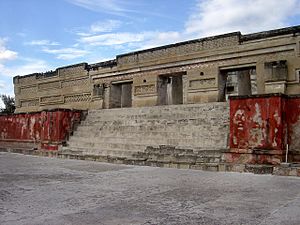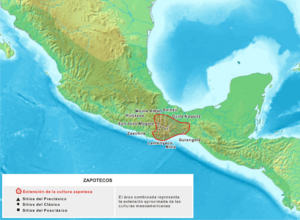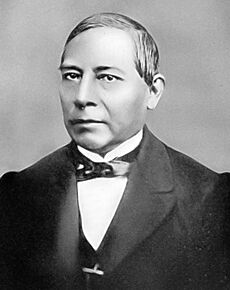Zapotec peoples facts for kids
| Bën za | |
|---|---|
 |
|
| Total population | |
| c. 400,000–650,000 | |
| Regions with significant populations | |
| Languages | |
| Zapotec, Spanish, English, Albarradas Sign Language | |
| Religion | |
| Christianity: Roman Catholicism, traditional beliefs | |
| Related ethnic groups | |
| Chatinos |
The Zapotec people are an Indigenous group from Mexico. They mostly live in the southern state of Oaxaca. You can also find Zapotec communities in nearby states. Today, there are about 400,000 to 650,000 Zapotec people. Many of them speak only one of the native Zapotec languages.
Long ago, before Europeans arrived, the Zapotec civilization was a very advanced culture. They even had their own Zapotec writing system.
Many Zapotec people have moved to the United States over the years. They have their own groups in Los Angeles and the Central Valley in California.
There are four main groups of Zapotec people:
- The istmeños live in the southern Isthmus of Tehuantepec.
- The serranos live in the northern Sierra Madre de Oaxaca mountains.
- The southern Zapotec live in the southern Sierra Sur mountains.
- The Central Valley Zapotec live in and around the Valley of Oaxaca.
Contents
What Does "Zapotec" Mean?
The Zapotec people call themselves Bën Za. This means "The People."
For a long time, people thought the name Zapotec came from the Nahuatl word tzapotēcah. This word means "people from the place of sapote fruit."
However, new studies suggest it might be a mix of words. It could come from "za" or "zaa" (meaning cloud) and "pochteca" (meaning merchant). So, it might mean "cloud merchants."
A Look at Zapotec History

Experts believe the Zapotec people lived in the Central Valley of Oaxaca as early as 500 to 300 BCE. This time is known as the Monte Alban I period. During this period, the Zapotecs created a strong government for their region.
The Monte Alban periods lasted from 500 BCE until 1521 CE, when the Spanish arrived. Old ruins at Monte Alban, which was "the first city in ancient Mesoamerica," show people lived there as far back as 1150 BCE.
Historians divide Zapotec history into stages:
- Formative Stage (500 BCE to 200 CE): People started living in settled villages. They began farming to get food.
- Classic Stage (200 to 900 CE): Social and political groups grew stronger. Religious activities also became very important.
- Militaristic Stage (900 to 1521 CE): Warfare became common among Mesoamerican societies. States often fought each other.
Zapotec Culture
Languages of the Zapotec People
The Zapotecan language group has over 60 different ways of speaking. It also includes the Chatino language, which is closely related. The most common variant is Isthmus Zapotec. This is spoken on the Pacific coast of Southern Oaxaca.
Zapotec Beliefs and Religion
Most Zapotec people today are Catholic. However, some of their old beliefs and customs are still practiced. For example, they sometimes bury their dead with valuable items.
Some Catholic saints in the area look like old Zapotec gods. San Pedro, for instance, looks like Cocijo, the Zapotec rain god. Early missionaries came to the Zapotec people. Two of them were Bartolomé de Olmeda and Juan Díaz. Juan Díaz was killed for destroying their idols.
The Virgen de Juquila is a special Catholic figure in Oaxaca. Many Zapotec Catholics go on a yearly trip to visit her statue. This happens from December 7 to December 9.
Before the Spanish arrived, the Zapotec government and religion were not separate. Zapotec leaders had to be trained in religious practices. They built large temples called yo hopèe, or "house of the vital force." Priests performed religious ceremonies there.
The Zapotec believed in a "life force" called pè. This force lived in nature, like wind and breath. It was also the spirit of all living things. Priests, called Copa pitào, were usually chosen from noble families. They received special training. Common people could also become priests, but only in lower ranks.
The highest religious leader was the ouija-tào, or "great seer." Spanish accounts compared him to the Pope. This leader lived in Mitla, not Monte Alban.
The Zapotec religion had many gods. They linked different parts of nature to their gods.
- Pitao Cozobi: The main god, linked to corn and farming.
- Cocijo: God of rain and lightning, similar to the Toltec god Tlaloc.
- Pitao Cozaana: Creator of people and animals, god of ancestors.
- Pitao Hichaana: Goddess of people, animals, and children. She was also a mother goddess.
- Pitao Pezelao: God of the underworld, death, and the earth.
- Copijcha: The Sun god and god of war.
- Pitao Xicala: God of love, dreams, and too much of anything.
Zapotec Women and Their Contributions
Zapotec women in Oaxaca have many important roles. They are vital to their families and communities. Historically, their roles were different from men's roles.
Men and women often work separately. They come together for meals and during special events.
Women's Work and Family Life
Zapotec women are very important as mothers. They are responsible for raising children. They also take care of the home, including cooking and cleaning. Many women also work to help support their families.
In the past, when farming was most important, men did most of the planting and harvesting. But women also helped with weeding and harvesting. Women often brought food to the men working in the fields.
Today, things are changing. Mexico's economy is moving from farming to services and manufacturing. Women now have more ways to earn money for their families. They can still do their work at home, which has no money value.
As men move to other jobs, women have become very important in the textile industry. This industry mainly serves tourists. Weaving and factory work are now a big part of life for many Zapotec women.
The clothing industry started around 1960. Women began making and designing shirts and trousers to sell. This industry has greatly helped Zapotec women earn money. They use different ways to produce goods, from working at home to joining weaving groups.
Women's increasing involvement in the market is changing their role in society. Women who are merchants are often seen as having a higher status than workers.
In Zapotec communities, jobs are often divided by gender. Even though men can be overseers in the textile industry, it is mostly seen as "women's work." Because women control this industry, it is sometimes seen as less important.
People in Zapotec communities respect women's ability to help the family economy. However, they are sometimes thought to be less capable than men as managers. Their work is sometimes seen as less important.
Zapotec products, like textiles and clothing, are sold in the U.S. and other parts of the world. This is changing the local economy in Oaxaca.
In the central valleys of Oaxaca, Zapotec villages often specialize in one craft. For example, people in San Bartolo Coyotepec are known for their black pottery. People in San Martín Tilcajete are famous for their carved and brightly painted wooden figures.
The type of weaving also affects who does the work. In villages like San Bartolo Yautepec, women do back-strap weaving. This makes lightweight fabrics for things like table runners and purses. In Teotitlán, Santa Ana del Valle, and Villa Díaz Ordaz, men mostly weave rugs on large looms. However, women are also weaving more rugs now. Women's earnings from weaving give them more independence. But their main job is still feeding, clothing, and caring for their families.
Famous Zapotec People
- Benito Juarez: He was born in Oaxaca to Zapotec parents. Benito Juarez was a political leader in Mexico. He was the first president of Mexico who was of Indigenous origin.
- Andrés Henestrosa: A Zapotec scholar who studied the Zapotec language and culture. He later became a politician.
More to Explore
 In Spanish: Pueblo zapoteco para niños
In Spanish: Pueblo zapoteco para niños
- Indigenous people of Oaxaca




